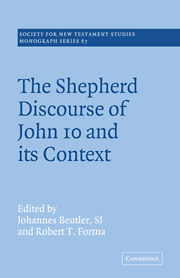Book contents
- Frontmatter
- Contents
- List of abbreviations
- Introduction
- 1 Open questions on John 10
- 2 Der alttestamentlich-jüdische Hintergrund der Hirtenrede in Johannes 10
- 3 The history of religions background of John 10
- 4 Tradition, history and interpretation in John 10
- 5 John 10 and its relationship to the Synoptic Gospels
- 6 A syntactical and narratological reading of John 10 in coherence with chapter 9
- 7 Johannes 10 im Kontext des vierten Evangeliums
- Notes
- Index
1 - Open questions on John 10
Published online by Cambridge University Press: 10 October 2009
- Frontmatter
- Contents
- List of abbreviations
- Introduction
- 1 Open questions on John 10
- 2 Der alttestamentlich-jüdische Hintergrund der Hirtenrede in Johannes 10
- 3 The history of religions background of John 10
- 4 Tradition, history and interpretation in John 10
- 5 John 10 and its relationship to the Synoptic Gospels
- 6 A syntactical and narratological reading of John 10 in coherence with chapter 9
- 7 Johannes 10 im Kontext des vierten Evangeliums
- Notes
- Index
Summary
John 10, on the shepherd, is a passage which, while undoubtedly attractive, is laden with all the exegetical problems characteristic of John's gospel. Not only is the beginning disputed, but also its form, inner structure, in part its wording, and most of all its place in the larger context and also the thrust of the chapter.
Here the task will be limited to examining in light of the text the validity of answers given by scholars to some of the problems. Accordingly, questions of the origin and later use of the imagery, as well as the significance of Biblical allusions for the interpretation, will only be dealt with in passing. Our plan results from the task before us. Literary questions will be discussed before we turn to theological issues.
Literary problems
One literary problem of chapter 10 consists in what is often felt to be a loose insertion of the shepherd speech into its present context. This “impression” is usually substantiated by pointing to the supposedly abrupt change of topic, and to the surprising transition to a different narrative genre between 9:39 and 10:1. Yet these observations apply only to the beginning of the speech. As the chapter develops, verses 26b–28 are presupposed in the preceding material. The classic solution for this supposed enigma is provided by literary criticism. From a literary point of view two possible solutions have been offered over the past hundred years. One explores the traditionhistorical ‘growth’ model, according to which various sources have been arranged redactionally by a third party, or one piece of text has been inserted later. The other suggestion employs the ‘rearrangement’ hypothesis.
- Type
- Chapter
- Information
- The Shepherd Discourse of John 10 and its Context , pp. 6 - 17Publisher: Cambridge University PressPrint publication year: 1991



